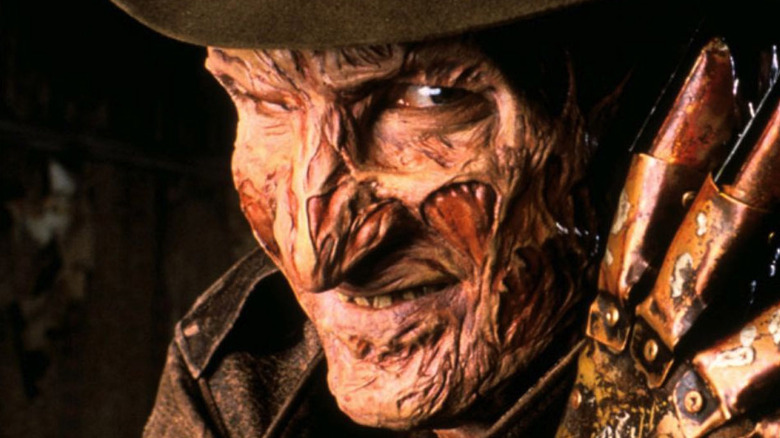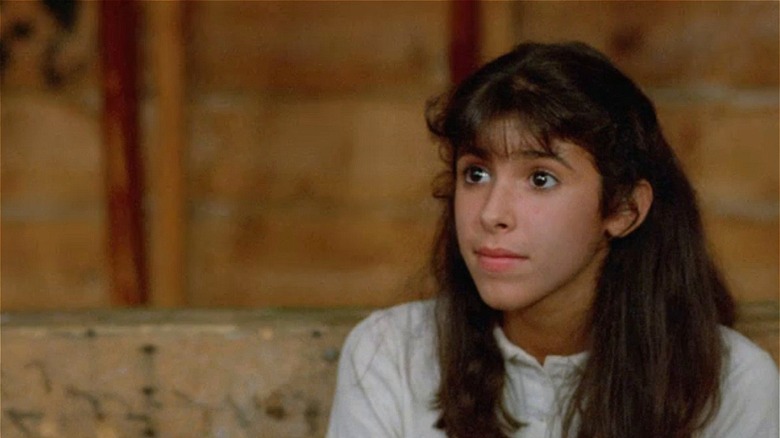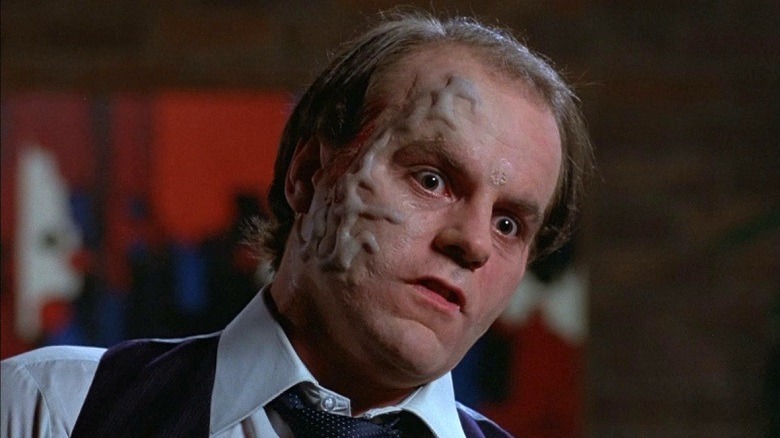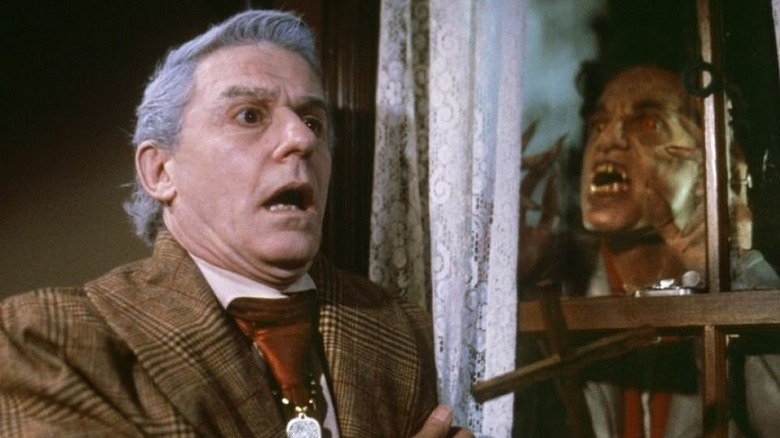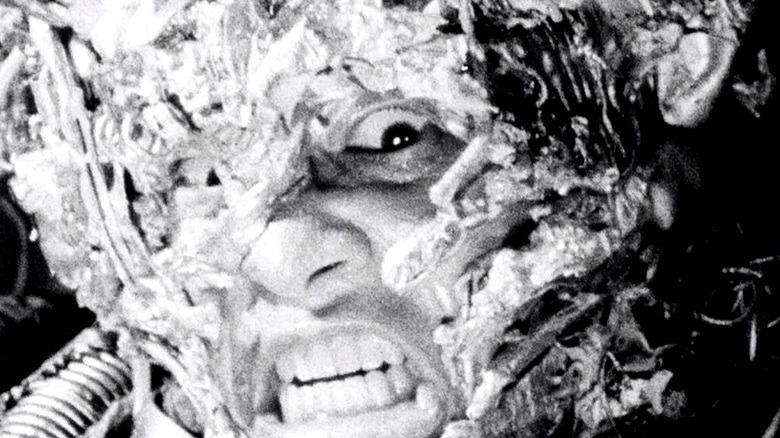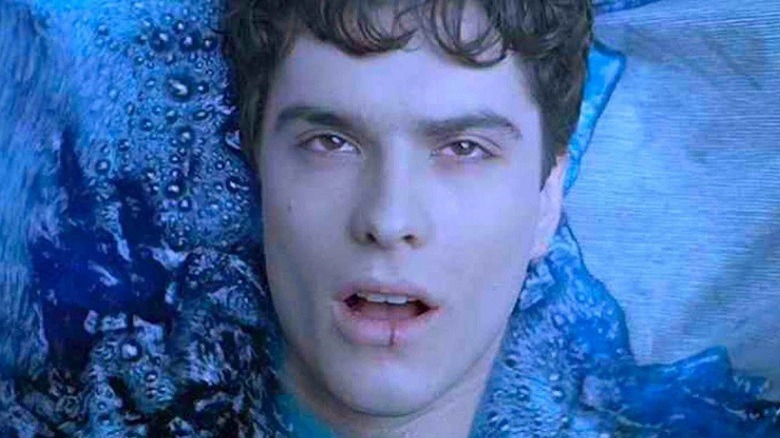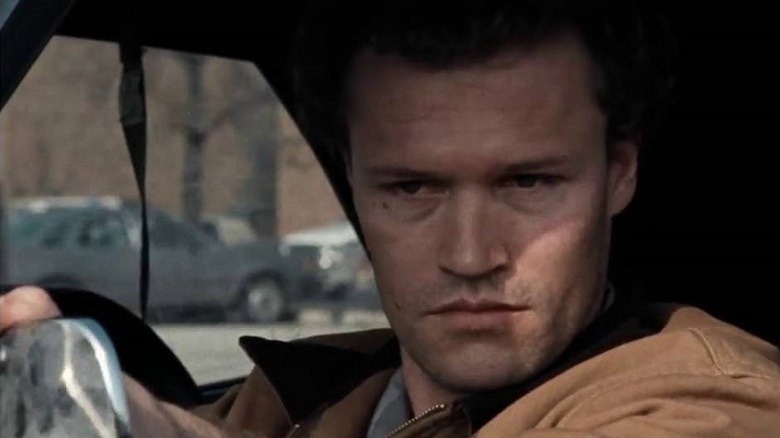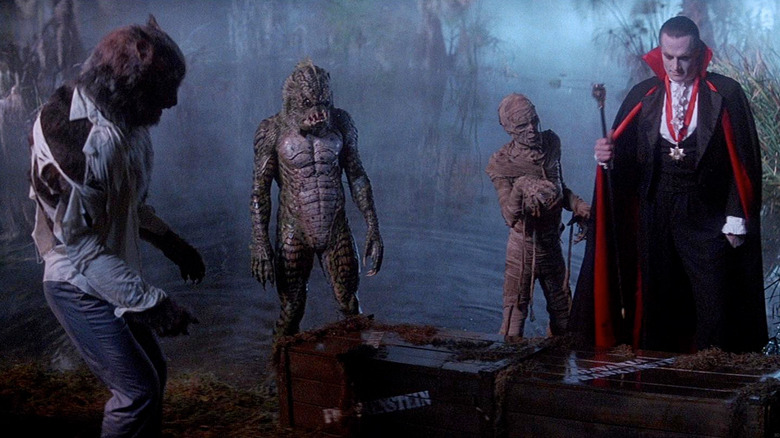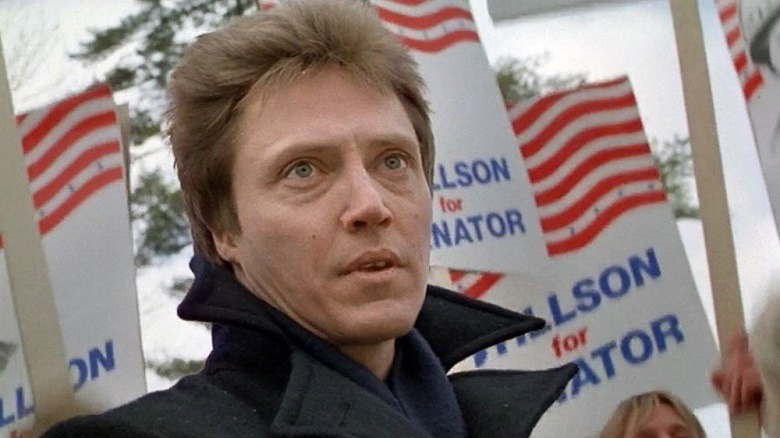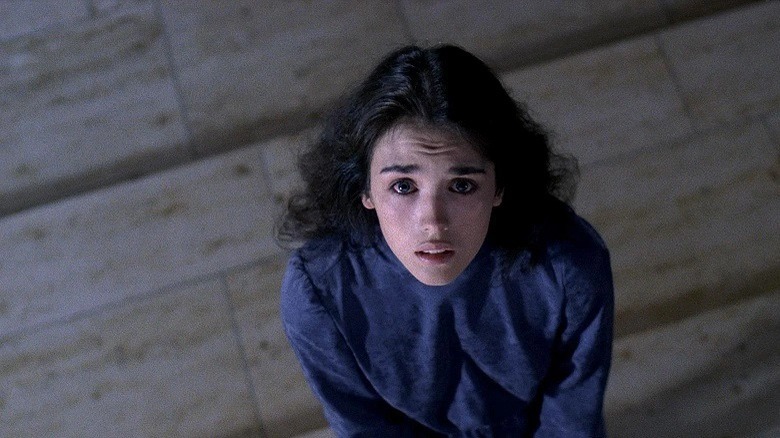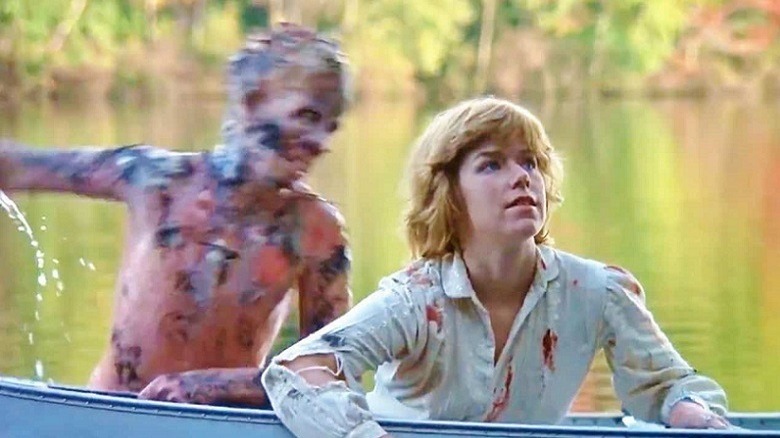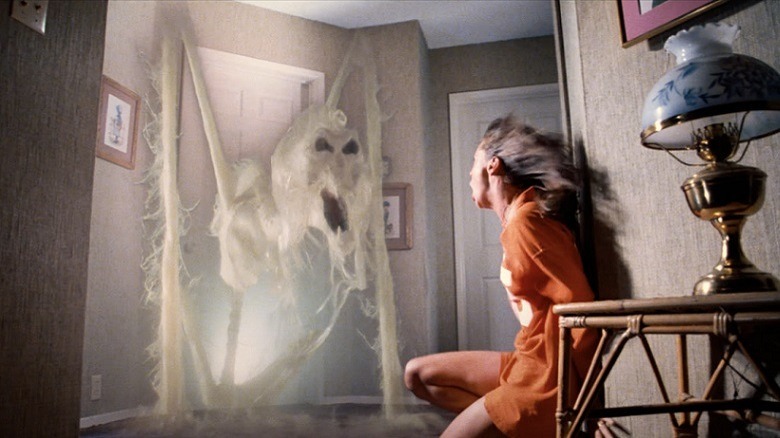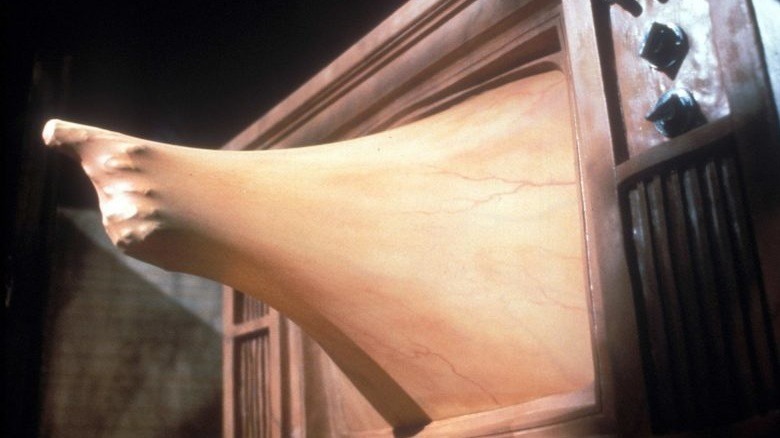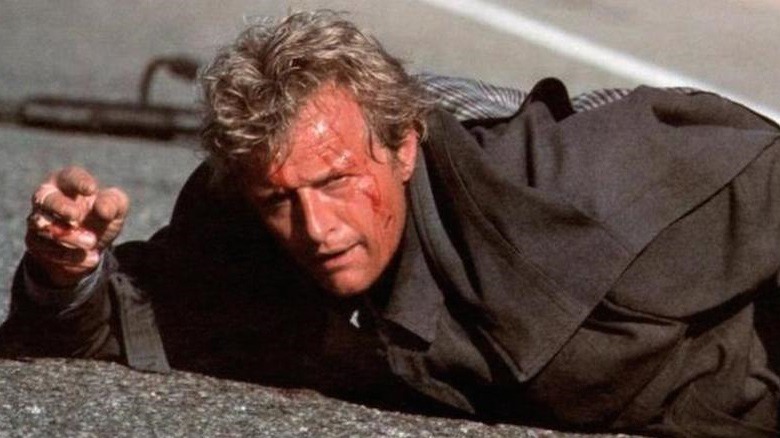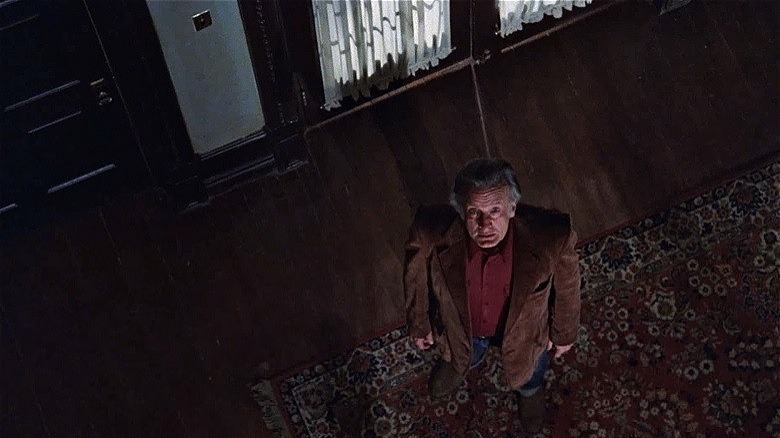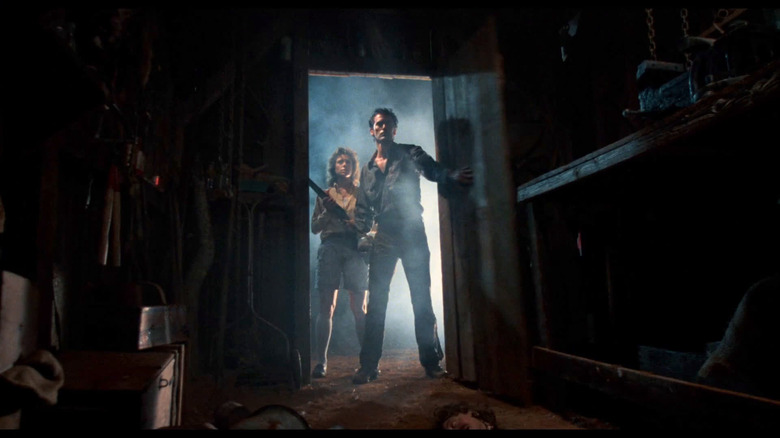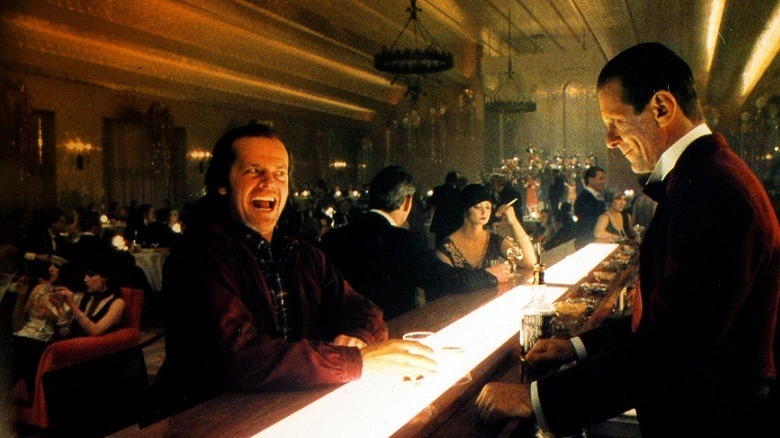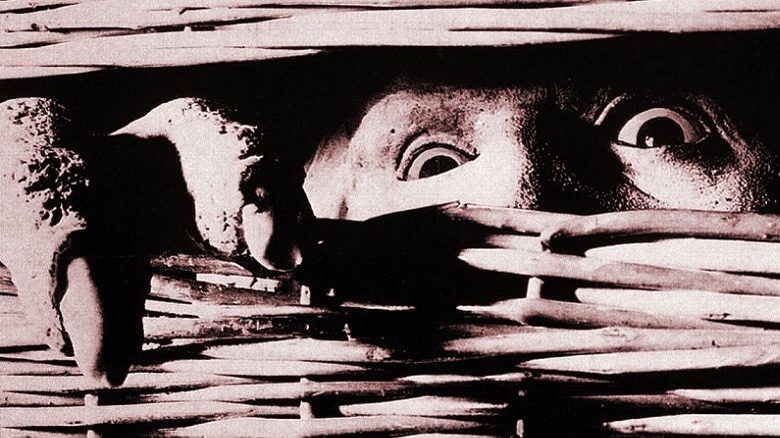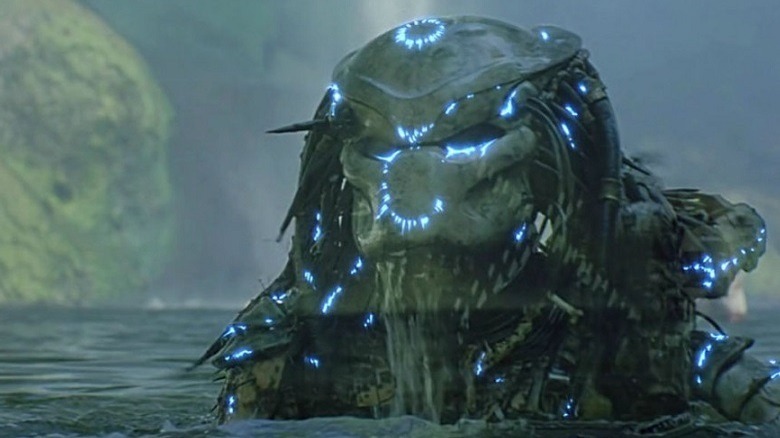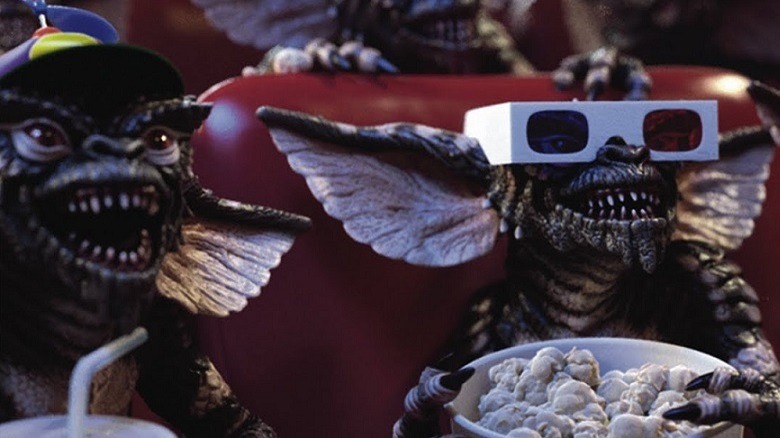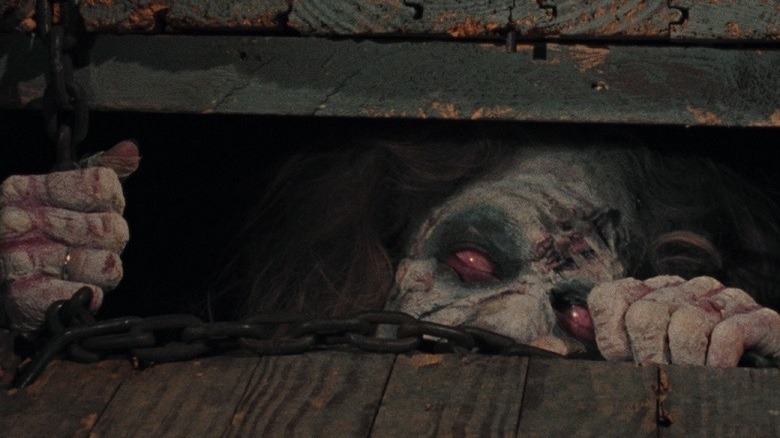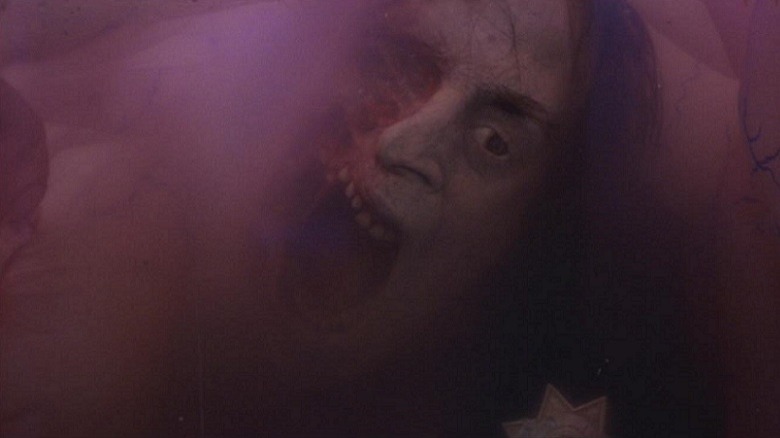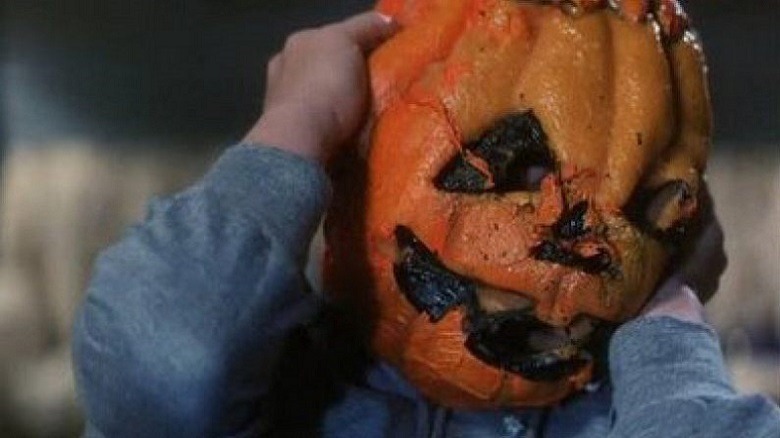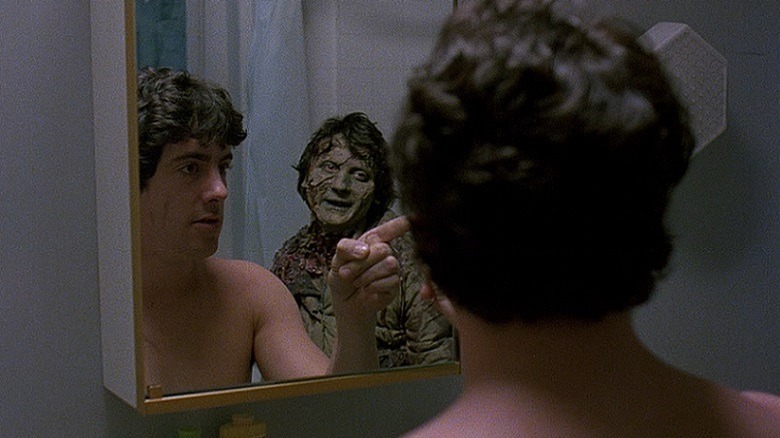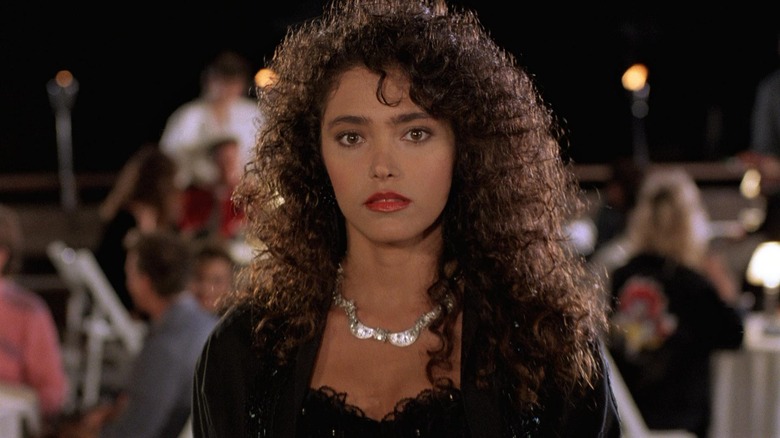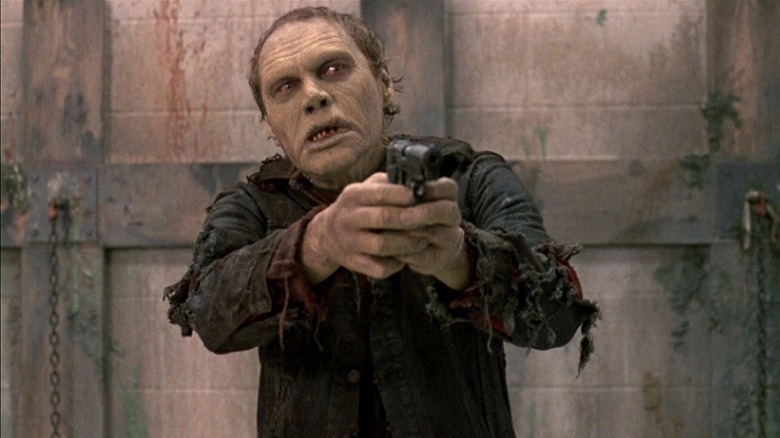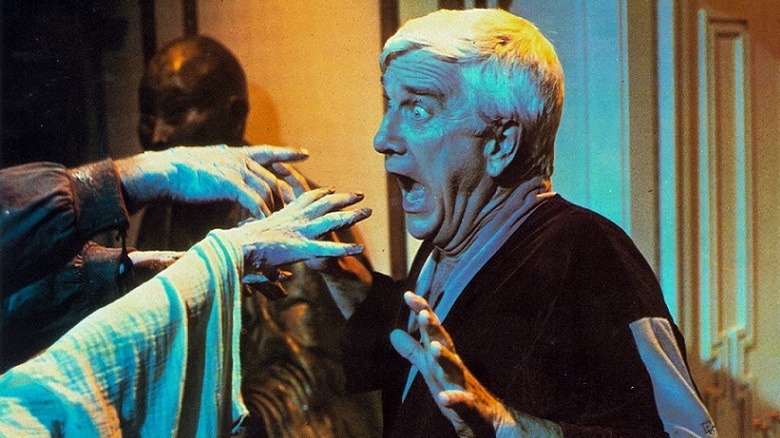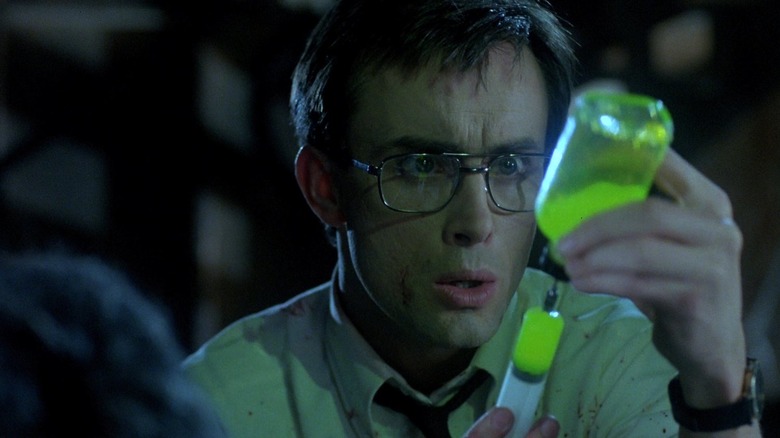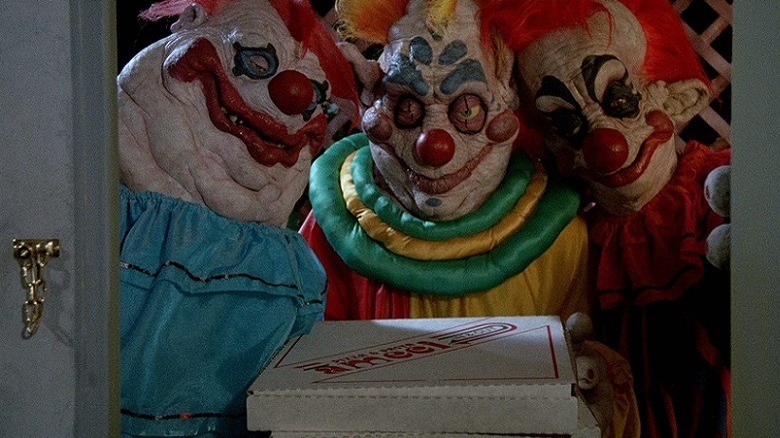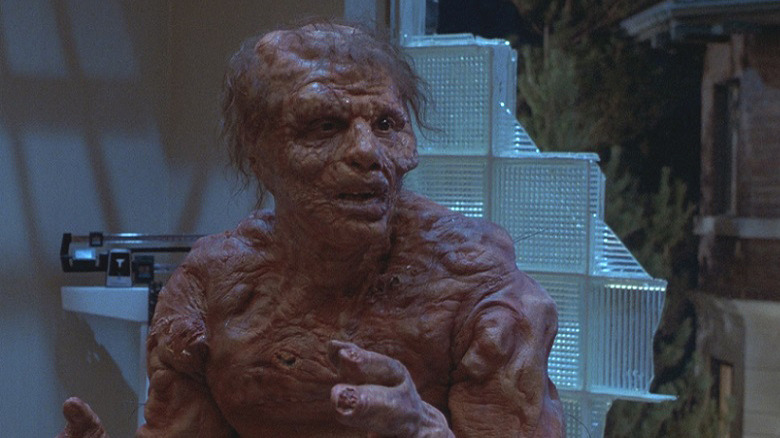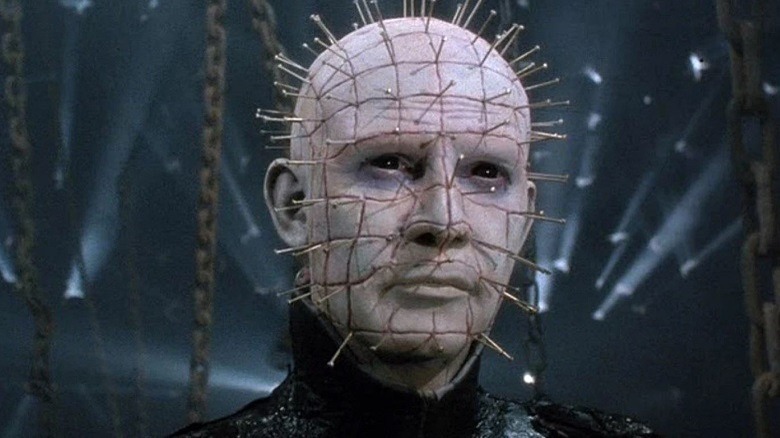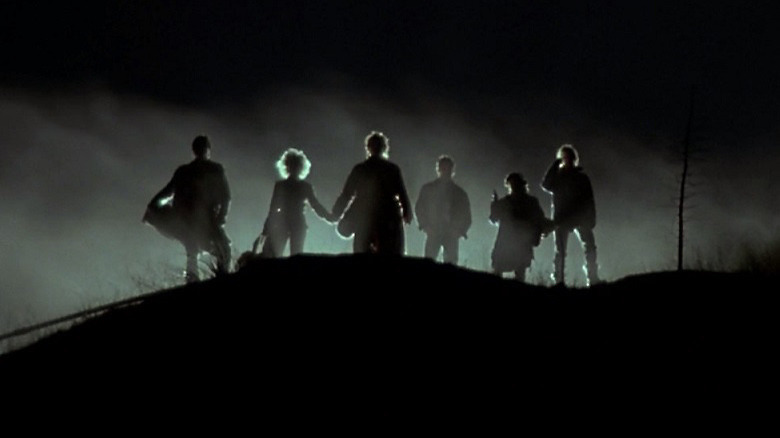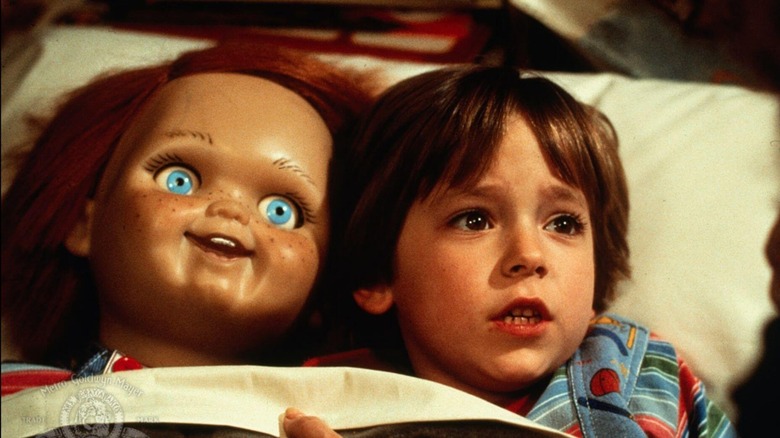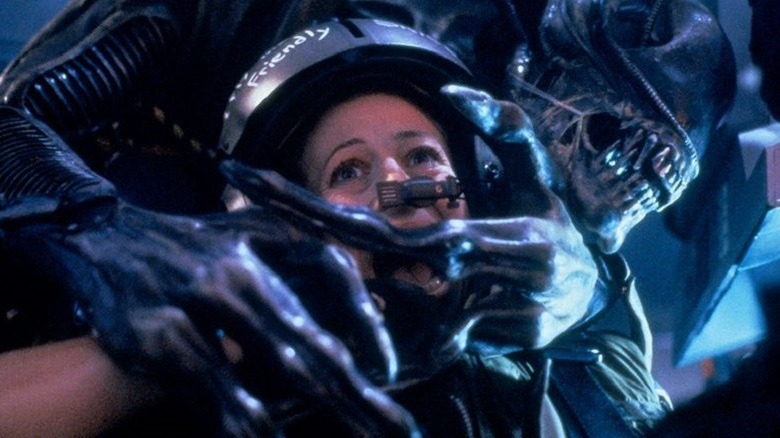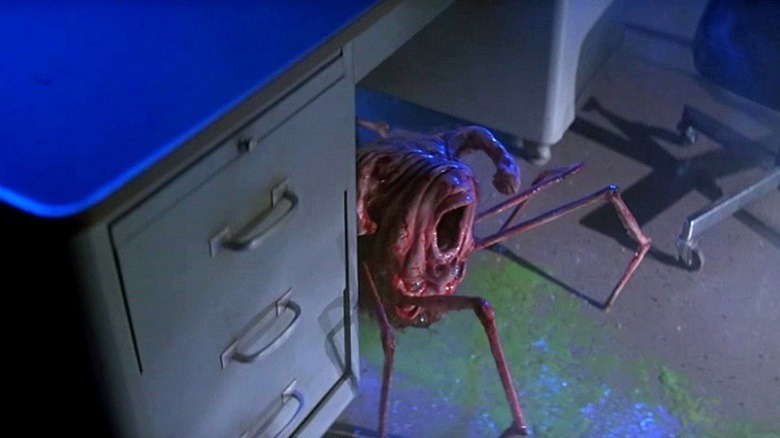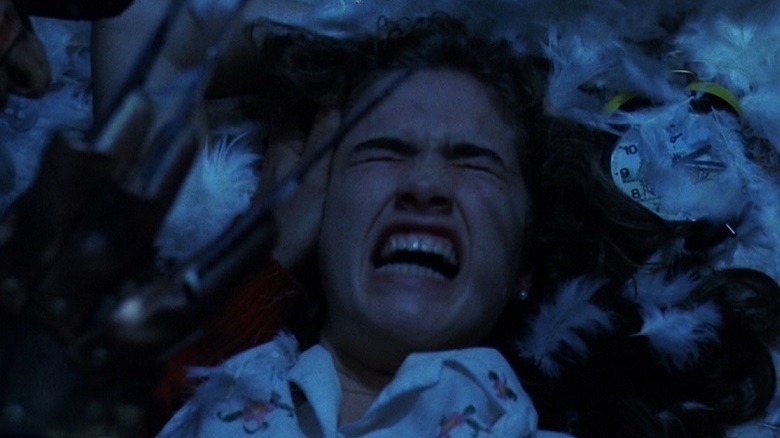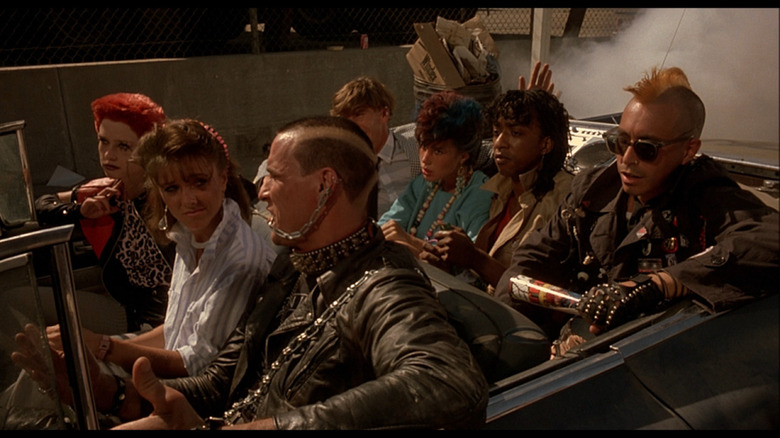The 36 Best '80s Horror Movies Ranked
The '80s were a boom time for horror. Two formats of video recorder (VHS and Betamax) duked it out, with VHS eventually winning due to being the cheaper format to license. The proliferation of this technology in the home meant that films had a market beyond cinemas for the first time, and rental stores cropped up worldwide. Direct-to-video became a valid way to release films, and a lot of people wanted to cash in on the growing horror craze. In addition, because it was now possible to record movies from their TVs, many eager youngsters cultivated an interest in horror by watching scary movies at home, freed from the age-based restrictions at theaters.
My childhood was one of regular video shop visits, marveling at the gory covers on cassettes in the horror section. The quality of the tapes varied wildly, but many still hold up today, and some of them now bona fide classics. Obviously, any list such as this is subjective, but there are a few entries that I'm genuinely sad missed the cut, even if just barely — especially "From Beyond."
Adjust your tracking, align your azimuth heads, and let's go...
37. Sleepaway Camp
If 1980's "Friday the 13th (alongside films like "The Burning") hadn't already taught us that there were few places as dangerous as summer camp, 1983's "Sleepaway Camp" proved it beyond any doubt. Summer camp counselors must have been up there alongside snake handlers and bomb disposal crews in the '80s, and at least those pursuing the latter two careers are given better protective garb than short shorts and crop top tee-shirts. It would appear that a disgruntled parent or vengeful (and permanently scarred) victim of bullying lurked behind every tree or chalet.
An unlikely film to kickstart a franchise, "Sleepaway Camp" would go on to spawn several sequels, each more tongue-in-cheek than the one before. Honestly, as a slasher — especially one in such an overcrowded market given the number of "Friday the 13th" imitators inspired by that film's breakout success — this particular entry is very much by-the-numbers, and the characters a collection of broadly drawn archetypes in a movie particularly guilty of having 30-somethings trying to play young teenagers.
That said, it's solely the movie's ending that makes "Sleepaway Camp" worthy of inclusion on this list. A striking reveal and final shot instantly elevate the film from forgettable to quite the opposite, and it's a conclusion that still stands up as brave and shocking some four decades later.
36. Scanners
There's a general rule of thumb that the appearance of actor Michael Ironside improves any film, and this certainly applies to the 1981 science fiction/horror flick "Scanners." Ironside plays the baddie in this tale of weaponized psychics in a setting that will be familiar to any fans of the works of Canadian auteur writer/director David Cronenberg — a reality parallel to ours, but one where technology or humanity has gone awry.
In his earlier works "Shivers" and "Rabid," Cronenberg dealt with his familiar themes of disease, but in "Scanners" (and "The Brood" from two years previous) he delves into the powers of the mind and those who would exploit them.
The plot is as ambitious as it is mind-blowing, which leads us neatly into the one famous moment that cemented this visceral and literate science fiction film's place in the horror hall of fame. The villainous Darryl Revok (Ironside) turns his particularly vicious telepathic talents against another psychic, causing his head to explode messily. The scene — achieved with a prosthetic full of burger remnants, latex, and wax shot at point-blank range with a shotgun — has gained notoriety, immortalized in countless animated GIFs. It's a gimmick in a film that doesn't need one, but also a prime example of practical effects work that still stands up today.
35. Fright Night
Nostalgia is a powerful drug, and if 1985's "Fright Night" will make you long for anything, it's the concept of old-fashioned horror hosts. Those stalwart individuals — of whom Elvira was one of the most famous — haunted our screens in the dead of night on cable television, introducing a succession of schlocky low-budget, yet thoroughly entertaining, horror movies.
In this tale of a vampire moving into a suburban neighborhood and the attempts to uncover him, Roddy McDowall plays the aforementioned horror host — Peter Vincent — dragged into a real-life vampire hunt. He delights as a pretentious luvvie with ideas above his station, proving to be quite hopeless in real life at the abilities boasted about by his on-screen persona. In a metaphysical twist beating "Scream" to the punch by some time, it's also a neat skewering of the 80s trend of horror switching towards slasher movies, with has-been Vincent bemoaning modern audiences don't even have time for creatures such as vampires anymore.
The '80s were a rich era for comedy blended with horror, and "Fright Night" boasts a razor-sharp script as gruesome as it is funny. A vampire flick is also only as good as its bloodsucking lead, and here Chris Sarandon stars as the confident and suave suburban sucker Jerry Dandridge (vamping it up a couple of years after former wife Susan had done the same in "The Hunger").
34. Tetsuo: The Iron Man
The cinematic equivalent of a monochromatic fever dream, this 1989 Japanese splatter-punk body horror is as contentious as they come. Critics will point out its paper-thin plot, ramshackle special effects, and over-the-top gore — and fans will proclaim those elements as exactly why they love it.
The vague plot follows our protagonist, The Salaryman (Tomorowo Taguchi) as he contracts a mysterious illness that causes him to slowly transform into a hideous bio-mechanical hybrid of flesh and metal. An encounter with a metal fetishist forces the two rusting reprobates into a deadly battle.
A minuscule budget and a do-it-yourself approach to the special effects give "Tetsuo: The Iron Man" a unique look, making it quite different from other horror movies. Sequels would up the budget and the quality of special effects — and the complexities in the storytelling — but this first low-budget horror, with its punk-rock ethos, remains the most fascinating entry of them all. "Akira" would tread similar territory in the same decade with its own metamorphosing and mutating Tetsuo to greater and more profitable effect. Still, there's no doubting the low-fi charm of this strange little film, and you'll never look at a junk pile in the same way again.
33. Brain Damage
In 1982's "Basket Case," writer/director Frank Henenlotter created a most unusual antagonist in Belial, a monstrously deformed conjoined twin. However, that pale-skinned, potato-shaped creature was the paragon of normality compared to Aylmer from Henenlotter's next film, "Brain Damage." Aylmer, a purple and blue chorizo-shaped parasite, is a millennia-old creature with perfectly polite diction — and a penchant for eating brains in return for injecting his acolytes with a chemical capable of causing vivid and exquisitely pleasurable hallucinations. In a knowing nod to low-budget horror, Aylmer is voiced by John Zacherle, who was a renowned host — known as The Cool Ghoul — throughout the '50s and '60s.
Protagonist Brian (Rick Hearst)– with that name and film title similarity being one of the most refined elements of this 1988 comedy horror — stands front and center in this outlandish slice of cinema. It simultaneously takes a sledgehammer-subtle approach to addiction and serves as a violent gore-fest, with each killing presented in a neon brilliance from a narcotic haze rivaling anything seen in Joel Schumacher's "Batman Forever."
There's no denying a running theme in Henenlotter's output, which typically involves a grimy New York underbelly populated by sleazy unsympathetic characters getting what's coming to them. That said, his brand of horror exploitation cinema is unique, and it's no exaggeration to call Henenlotter something of an auteur. There's little reason or logic behind his works, but their distinctiveness makes them stand out in a crowded genre. Like the vicious stinger that Aylmer uses to squirt his potent narcotic all over your cerebral cortex, his films get into your brain.
32. Henry: Portrait of a Serial Killer
Before Alabamian actor Michael Rooker emerged as James Gunn's cinematic muse (appearing in "Slither" and various "Guardians of the Galaxy" films), he terrified audiences as the lead in John McNaughton's 1986 psychological horror "Henry: Portrait of a Serial Killer."
Based on the story of real-life killer Henry Lee Lucas, this gritty movie follows Henry after his release from imprisonment for murdering his mother. Taking a job — appropriately — as an exterminator, he and a friend conduct a series of indiscriminate killings. From a decade in which movie murders were designed to be as novel as possible — with the bigger the body count, the better — "Henry" stands as a grimly realistic and sobering view of a mass murderer's mind.
Henry isn't a masked slasher or supernatural creature out for vengeance or killing for a misguided cause, but an anonymous psychopath who could blend into the crowd, and whose motives appear random. The movie is awkwardly voyeuristic at times, making us, the audience, feel guilty for watching Henry carry out his hideous crimes with a casualness that defies sense. It'd be a challenge to find a more nihilistic movie from the '80s, and it's pretty telling that it sat in post-production limbo for three years before becoming one of the first movies given the Motion Picture Association of America's new NC-17 rating.
31. The Monster Squad
If the success of "Stranger Things" has taught us anything, it's that people absolutely love stories about rapscallion kids on bikes dealing with circumstances bigger than their wildest imaginations. The 1980s loved telling stories about young friend groups getting into hijinks, with films like "E.T.: The Extra-Terrestrial," "The Goonies," and "Stand By Me" all viewed now as seminal coming-of-age classics. Delightfully, the horror genre had its own version of this sort of film, with Fred Dekker and Shane Black's cult classic, "The Monster Squad." Few films genuinely capture the latchkey spirit of the 1980s better, and for as much as we're nostalgic for the 1980s today, the 1980s of "The Monster Squad" gleefully embraced the nostalgia for the classic Universal Monsters of yesteryear in a way that could appeal to audiences young and old.
It's the ultimate story of friendship and battling not just the trials of growing up but saving their town from literal movie monsters who have no problem calling an elementary school girl the b-word. "The Monster Squad" is a deeply funny movie even if certain language elements haven't aged all that well (that's true for all comedies, for the record), but it's the ultimate gateway horror film to help younger viewers transition from family-friendly spooky films to more intense scares. You're never too young or too old to learn how to face your fears or the ever-important lesson that "Wolfman's got nards."
30. The Dead Zone
You'd struggle to think of two things more ubiquitous in '80s horror than David Cronenberg and Stephen King, and 1983's "The Dead Zone" sees a collaboration between the two genre legends.
In a case of perfect casting, Christopher Walken plays Johnny Smith. Walken is always at his strongest playing unusual, haunted characters (case in point: his scene-stealing performance as the Archangel Gabriel in 1995's "The Prophecy") — and Smith is one of the most interesting of them all. He wakes from a coma to find himself able to catch glimpses of individuals' lives through touch, this psychometric talent capable of discovering people's secrets — by seeing their futures. Accidental contact with presidential candidate Greg Stillson (Martin Sheen) shows the Senator will go on to start World War III, and Smith is locked in a battle against time to prevent this seemingly inevitable prophetic apocalypse.
Despite feeling a little dated given recent events in modern politics — where few in positions of power seem to have the honor anymore to resign with dignity when embarrassed or shamed — it's a powerful film. The final act is a slice of brilliantly tense cinema, and "The Dead Zone" has proven to be one of the most effective of King's works put to screen. The '80s saw a great many King adaptations, but notably, few of them feature on this list, such is their varying quality.
29. Possession
Enjoying somewhat of a resurgence due to its recent appearance on the streaming channel Shudder, 1981's "Possession" was one of several films from the decade that found itself on the list of British "Video Nasties." Whereas many films found themselves on that notorious list through their extreme gore and that alone, "Possession" was also included for its sheer brutality and uncompromising view of domestic abuse. This far-from-comfortable watch charts the breakdown in the relationship between spy Mark (Sam Neill) and Anna (Isabelle Adjani), and follows her increasingly odd behavior after requesting a divorce. It flits through genres, beginning as a grim kitchen-sink divorce drama in the equally grim environs of West Germany before the fall of the Wall, yet ends up in Cronenberg-esque body-horror territory. Neill is never anything less than watchable in any of his roles and "Possession" is no exception. Still, it's Adjani who steals this movie — with one subway scene in particular memorable as a high point of horror cinema.
It's an oddly structured narrative that asks as many questions as it answers, and it's definitely not a film for everybody's taste — but if you like your horror challenging and ambiguous, there are few better examples in '80s cinema. I can guarantee you that it's like nothing you've ever seen — or will ever see.
28. Friday the 13th
It was the film that launched a franchise, eventually seeing its protagonist visit the far-off climes of Hell, outer space, and — most terrifyingly — Manhattan. It's incredible to think that a series that went on to form an instantly recognizable horror legend in the form of Jason Voorhees and his iconic hockey mask started without even his inclusion, Jason's only proper appearance being an afterthought (inspired by the end of "Carrie") in a dream sequence.
Rushed into production to capitalize on the success of "Halloween" (1978) from two years earlier, "A Long Night at Camp Blood" (to use its working title) was a compelling whodunit with the identity of the murderer kept a secret from the audience. The ultimate reveal wasn't as effective as the thrills and chills that led up to it, but there is no denying how influential this film was on the genre. The excellent (and lengthy) documentary "Crystal Lake Memories" explores the sad tale of diminishing returns and how the series eventually lost its way, but it's easy to forget how it once dominated the box office.
And while "Friday the 13th" spawned countless mediocre spin-offs featuring hapless counselors in peril, the original still stands tall today. All together now ... Voorhees a jolly good fellow ...
27. Poltergeist
"Poltergeist" is an odd beast. Tobe Hooper, who'd terrified the living snot out of us eight years earlier with "The Texas Chainsaw Massacre," directed this 1982 horror film, but it feels like a film straight out of the Spielberg playbook. Spielberg's influence as the tale's writer imprinted on every frame, and there's an argument — with no small irony in a film about a restless spirit — that Spielberg ghost-directed the movie. And it's easy to see how people came to believe that.
Hooper (or maybe Spielberg) lulls you into a false sense of security as the characters start witnessing odd activity in their new home (another example of '80s homeowners blissfully unaware of what lurks under the foundations of their building — although at least in this case we were spared the common trope of Indian burial ground). The titular poltergeist is initially playful, moving furniture around accompanied by a cheery Jerry Goldsmith score, as well as communicating with the family's young daughter through the static on a television set. ("They're heeeeere.")
There's a big rug pull to come, though, as the film suddenly descends into the macabre and cruel. There's a mirror scene involving face-peeling horror that would be considered over the top in a Cronenberg movie, and moments of terror you wouldn't expect in a film with such a mild rating; it was rated the equivalent of PG (Parental Guidance) in the UK, which seems laughable now given the film's haunting content.
26. Videodrome
With the dawn of the video cassette being such a boon for the horror genre — for both viewers and filmmakers, as touched upon in my introduction to this piece, it was inevitable that somebody would deliver a film about the power of that medium. And who better than a director who seemed obsessed with impressing upon us the dangers of over-reliance on technology?
1983's "Videodrome" follows TV channel president Maxx Renn (James Woods) as he attempts to uncover the secrets behind the titular TV show — a gratuitous offering dedicated to torture and abuse — after he learns that the on-screen violence might be genuine. It's a wry — and, as you can imagine from director David Cronenberg, a far-from-conventional — look at the increasingly graphic nature of the content we consume, and the lengths that television creators will go to satisfy that urge.
The VHS concept and clunky on-screen technology date the film, locking it in an alternative '80s, but the theme remains as prescient as ever when we consider how the medium has changed in the 40 years since its release. In an era of fake news, radicalization, and people famous for simply being famous, perhaps we've never wandered too far from the Videodrome.
25. The Hitcher
A masterclass in atmosphere and tension that probably resulted in far fewer hitchhikers being picked up in the decade of its release, 1986's "The Hitcher" still stands out today for its memorably callous antagonist, Rutger Hauer's John Ryder. It's precisely the kind of role that the sadly missed Hauer was best known for.
When young Jim Halsey (C. Thomas Howell) stops for a hitchhiker, he has no idea of the events he sets in motion. He narrowly escapes with his life from this self-proclaimed psychopath, and the two of them fight to the death on the desert plains.
There are shades of Roy Batty, Hauer's "Blade Runner" character, in Hauer's oppressive antagonist, with both coming across as Aryan, idealized superhumans. Ironically, Ryder feels even less human than Roy Batty's replicant. It's a movie reminiscent of Spielberg's "Duel" from the decade previous, seeing innocents in the wrong place at the wrong time, tormented simply for their bad luck. Like the persistently aggressive Truck from Spielberg's feature, Ryder is an unstoppable force of nature, a villain with little nuance or subtlety, in a film as bleak as it is violent. "The Hitcher" was remade in 2007 with Sean Bean in the lead role, but even an actor of his gravitas couldn't salvage something that should have been left on the curbside, thumb permanently outstretched.
24. The Changeling
Another exemplary horror starring George C. Scott, "Exorcist 3" narrowly missed being on this list by virtue of opening 11 months too late, but 1980's "The Changeling" is equally as fine — a wonderful and chilling tale released in an era known for jump scares and gore. The ghost story is a fine tradition that seems to be (no pun intended) a dying art, and "The Changeling" is a textbook example of seeing it done well.
Scott plays composer John Russell, who moves into a Seattle mansion after a car accident saw his wife and daughter killed. It's not long before he starts to experience supernatural phenomena and learns of the events that transpired in his 12-years-vacated house.
Co-writer Russell Hunter based the story on his own experiences in the Henry Treat Rogers mansion two decades before, but the tale almost feels secondary to Scott's excellent performance.. almost. His music teacher is a haunted soul — both literally and figuratively — and his reactions to the events around him make the drama utterly convincing. Scott's always been a compelling character actor, and his performance grounds some of the more far-fetched elements, making the plot work. "The Changeling," through atmosphere and sound design alone, frightened this horror fan on first viewing — and aspects of this standout film have stuck with me ever since.
23. Evil Dead II
1987's "Evil Dead II" is a quirky one — it's not exactly a sequel to the original, more a bigger budget remake that's played slightly more for laughs than the 1981 classic. The impressively chinned Bruce Campbell returns as Ash Williams, once again getting himself involved with scary supernatural shenanigans in a secluded shack. The Book of the Dead — the Necronomicon, heavily featured in the first three "Evil Dead" movies — is once again responsible, as ancient texts naively read aloud reawaken the Deadites who dwell in the surrounding woods.
The slapstick quotient is heightened considerably from the first film, with Campbell's physical comedy prowess conjuring images of a Three Stooges one-person show. His exploits with a myriad of miniaturized mimics are a particular highlight, as is the scene with his possessed hand (with the severing of said limb being responsible for one of the few visual gags ever put to screen ... based on an Ernest Hemingway novel).
It's a visual riot, ending with a perfect set-up for "Army of Darkness," which arrived in theaters in 1992 (and thus can't be included on this list). Purists may not want to think too hard about how the conclusion of "Evil Dead II" doesn't quite match the start of the next installment, but that's pure nitpicking.
22. The Shining
Stephen King may have famously hated Stanley Kubrick's 1980 adaption of his first bestselling novel, but there's no denying the quality of the notorious auteur's only stab at the horror genre. Author and recovering alcoholic Jack Torrance (Jack Nicholson) takes a job as a winter caretaker and moves his wife Wendy (Shelley Duvall) and son Danny (Danny Lloyd) into the Overlook Hotel. Given warnings from the hotel's manager that the previous caretaker had gone insane and killed his family, Jack's behavior becomes increasingly erratic, and it transpires that they're not the only occupants of the Overlook — but they are the only ones still alive.
The film has been somewhat overshadowed by the real-life horror story of actor Shelley Duvall's on-set experiences, but "The Shining" is an exemplary piece of horror cinema. It's beautifully shot, as you'd expect from a talent such as Kubrick, albeit a little clinical, but many of the set pieces remain chillingly effective today. The notorious "Here's Johnny" scene featuring an ax-wielding Jack has been spoofed and parodied so many times it's virtually a cultural landmark, but it's a reminder of how superbly Nicholson could play manic characters. Mike Flanagan's 2019 sequel "Doctor Sleep" revisited many of the iconic shots and scenes from "The Shining," acting as a timely reminder of how good they really were.
21. Basket Case
Frank Henenlotter has a rare directorial talent: the ability to cover every frame of celluloid with an intangible layer of grime. Across his limited yet illustrious career, New York has been as much a character in his films as any of the oddballs, eccentrics, or freaks he casts. "Basket Case" is as much a love letter to the Big Apple as anything made by Woody Allen, but concentrates on the city's rotten core: the seedy, sleazier side of the concrete metropolis.
"Basket Case" is a simple tale about a boy and his deformed mutant brother, but it's the humans in the film who are the real monsters. It's a tale that'll stick in your brain long after you've finished showering to try and wash the grubbiness away. Some of its effects are risible — a stop-motion scene with monstrous brother Belial trashing a hotel room is more about the "stop" than the "motion" — but, as with the rest of Henenlotter's work, there's a certain charm.
Henenlotter inspired a whole bunch of other filmmakers, notably Joe Begos ("Bliss" and "VFW") and Harrison Smith ("The Special"), proving that exploitation is alive and well. The "Basket Case" sequels veer more towards black comedy and away from horror, but are never less than watchable.
20. Predator
In some little backwater alternate reality, there's a far different version of "Predator" from the one that hit cinemas in 1987. In this universe, it's one of the more obscure movies of Schwarzenegger's oeuvre, an action-horror flick starring heavily disguised, little-known actor Jean-Claude Van Damme (who suffered a career-ending injury after an ill-timed jump in a preposterous looking rubber costume).
Luckily, that's not the one we got. Featuring the ever-reliable designs of genre genius Stan Winston, "Predator" is an unashamedly macho science-fiction action-horror movie which sees Dutch (Arnie) and his squad of war-film stereotypes take on the eponymous alien menace. Featuring enough ammunition to topple a third-world dictatorship, and biceps bulging with more veins than most of us have in our entire circulatory systems, "Predator" is an absolute blast.
Like Billy on the bridge, brave enough to take on the Predator with just a machete, the film is expertly executed. A novel sequel that moved the setting to the concrete jungle of Los Angeles was followed by increasingly dismal movies, but, unlike the Predator himself, the franchise refuses to vanish.
19. Gremlins
A rare piece of stealth-horror, this one, sneaking from the video store shelf into many homes thanks to the cute furry Mogwai on the cover. It'd be a little while before its true nature became apparent: "Gremlins" is a Tex Avery cartoon given lizard flesh, a violent, blood-spattered tale of evil little skittering demonic creatures. My nervous mother (who'd subsequently tried to warn me away from "Rosemary's Baby," calling it the "scariest movie ever") never quite forgave me.
At its heart, "Gremlins" is a movie-length cautionary tale, a reminder to always follow instructions. The gremlins and their leader, Stripe, are the yin to the cute Mogwai Gizmo's yang, wreaking havoc amongst the deserving and undeserving alike. The gremlins themselves are a force of nature, dispatched in a variety of grisly ways that'll delight the childish-at-heart and sicken people ;ole my dear-departed mum. It's manic, playful, and buzzing with a sugar-rush energy rarely found outside of Saturday morning cartoons, but there's a hint of the darkest elements of Grimm just lurking under the surface — Phoebe Cates' saddest Christmas story of all time is testament to that.
"Gremlins" is a film that gets away with a lot due to the violence being cartoonish and over-the-top, but that doesn't stop it being as worthy an entry as anything on this list.
18. The Evil Dead
Whatever they try and tell you, nostalgia is what it used to be. A lot of my love for the movies on this list isn't simply due to the films itself, but the memories the films evoke of times, places, and friends.
The early '80s saw the Video Nasty uproar in the UK, in which movies — typically from the horror and exploitation genres – were banned under the Obscene Publications Act, and filmmakers and distributors found themselves prosecuted. Bootleg VHS cassettes of "Video Nasties" were forced underground, passed between avid collectors and fans like a Russian athlete's urine samples at the 2014 Winter Olympics.
"The Evil Dead" was one such movie, with this writers' first experience of the seminal horror film being in a grubby caravan in a friend's garden in the summer of 1983. It could be argued that the sequel — effectively a bigger budget remake of the first — is the better movie, but there's a low-fi charm to the original. There's a joy in this style of guerrilla filmmaking, wringing the very most out of a non-existent budget. "The Evil Dead" displays all the hallmarks that Sam Raimi would come to be known for; bold camerawork, a frenetic pace and style, and a comic-book sensibility. The less said about the tree molestation scene, though, the better.
17. The Blob
"The Blob" is just one of several remakes on this list, all of which follow the same principle; do it bigger and better. The Steve McQueen original is a well-regarded, cheesy science-fiction B-movie with a novel and original antagonist. The remake is a brilliant piece of '80s body horror that time seems to be doing its darned best to forget.
Like Tom Savini's excellent remake of "Night of the Living Dead," the remake plays with the ideas of the original while subverting them for a modern audience. The jock that the film seems to be setting up to be the lead dies (horribly) in the first act, writer Frank Darabont and director Chuck Russell seem to have missed the bit in the Hollywood scriptwriter's handbook that says, "Don't kill any kids," and it all fits neatly with the '80s' obsession with conspiracies — "It was the Government what did it."
"The Blob" also sets itself up neatly for a sequel that would never come, the film getting lost amongst a heaving morass of summer releases. Still, it's great fun with some truly memorable gross-out moments, and, aside from some dated back projection work, still stands up well.
16. Halloween 3: Season of the Witch
Narrowly beating another John Carpenter movie ("The Fog") for a place on the list, "Halloween 3" sits in such a prominent position simply for trying — albeit failing — to do something new with the developing franchise. Attempting to break away from being simply the continuing saga of Michael Myers, this was a bold attempt to push the Halloween franchise in a new direction; namely, to make it a series of horror films based around the holiday itself, with no link to the Shape.
With a script originally by Nigel Kneale (of "Quatermass" fame), "Halloween 3" is a folk-horror tale at heart, brimming with concepts that Kneale relished, like the overlap between technology and old magic. He eventually distanced himself from the project, but his name runs through it like the writing on a stick of rock.
However, the true magic at work here is the sheer sexual magnetism of lead actor Tom Atkins. Jamie Lee Curtis' character in "The Fog" beds him within moments of meeting him, as does his investigative partner — Ellie Grimbridge — in this. Despite dodgy Irish accents and a jingle that'll infest your brain for weeks, "Halloween 3" is, in this writer's humble opinion, the best of the series.
15. An American Werewolf in London
Thanks to "An American Werewolf in London" there are a whole plethora of songs with "Moon" in the title that will trigger a Pavlov-conditioned response among a certain generation of horror fans, evoking imagery of violent transformations, unwelcoming taverns, and Jenny Agutter in a shower.
For a director with a rich heritage in comedy, "An American Werewolf in London" fits neatly into John Landis' filmography. It's a horror movie with a bloated, black comedic heart, elevating itself above its lupine peers from the same decade (namely, "The Howling" and its sequels). For an audience expecting the werewolf transformation to consist of the lead actor having more fur glued to his face before he appears from behind a piece of furniture, Rick Baker's moonlight change from David to lycanthrope was a revelation. This was no elegant metamorphosis from wolf to man, but an agonizing and brutal act in which bones rearranged themselves and skin stretched to the point of tearing open.
Effects aside, "An American Werewolf in London" is horror with genuine depth, faithful to the werewolf tradition, but with a modern slant. A risible sequel emerged from the moors nearly two decades later, but with none of the charm or humor of this horror classic.
14. Society
"Shunting." Such an innocent term, conjuring (to this Brit, anyway) images of steam trains and the golden age of rail. Well, watching "Society" will banish any such romantic notions from your brain, replacing the word's meaning with gross physical deformations and disgusting bodily absorptions.
Responsible for the notorious KY Jelly shortage of 1989, "Society" is a distinct film of two halves, a shifting amorphous mass that's ingested David Cronenberg and the cast of "Beverly Hills 90210." It introduces a metaphor as subtle as a house-brick to the chin, taking the adage to a logical — and repugnant — extreme: What if the parasitic rich really were feeding off the poor?
"Society" is trickle-down economics given malleable flesh, with a delightfully exuberant and grotesque final act that's well worth the wait. The aptly named Screaming Mad George is on FX duty in this paranoiac satire, and the practical special effects still stand out three decades later. Are the soulless people of "Society" aliens, or have they been here all along? A question still as valid and equally as unanswered today.
13. Day of the Dead
Any list of the top 20 horror movies of the '60s wouldn't be complete without "Night of the Living Dead," and to leave "Dawn of the Dead" out of a '70s chart would be verging on illegal. Similarly, "Day of the Dead" rightfully deserves a position here. Romero would ensure that the increasingly inaccurately titled "Trilogy of the Dead" would receive more entries in the next century, but none stand up to the original three.
The "Day of the Dead" trailer alone was enough to terrify audiences, an early example of a jump scare taken from the opening scene. As the (supposed) final entry in the trilogy, it portrays a group of survivors who may be the last remnants of mankind, hunkered together in an underground bunker. The last stragglers of a military operation which should have been long abandoned, it's a claustrophobic character study of confinement, as well as an excuse for some truly memorable and horrific effects work from Romero's long-time collaborator, Tom Savini.
Captain Rhodes' soldiers are just as terrifying as any of the undead, and it's the conflict between them and the civilian scientists that make for a tense and brutal showdown. The three surviving leads (Lori Cardille, Jarlath Conroy, and Terry Alexander) recently appeared together in intriguing photographs hinting at a return for the characters in an unofficial sequel to "Day of the Dead," nearly four decades later.
12. Creepshow
As a sucker for a well-done anthology movie, "Creepshow" is one of the better ones, edging out "The Twilight Zone" movie. A loving tribute to the old EC Horror comics of the '50s, it was the first collaboration between the sadly missed George A. Romero and Stephen King.
Whereas some '70s films brought EC Horror stories directly to the big screen (Amicus Productions' "Tales from the Crypt" and "The Vault of Horror"), "Creepshow" was simply inspired by the feel and theme of these comics. They all follow a similar pattern. All of the segments are modern morality tales: They're all about bad people doing dreadful things to good people, and eventually get their comeuppance. One segment starring King himself — "The Lonesome Death of Jordy Verrill" — acts more as a cautionary tale, the sage warning being, "Don't get meteor crap on your fingers."
The comic book motif is strong throughout, shots framed by borders with expositional text or filmed at bizarre angles, mimicking comic book panels. Lighting is in bold, garish colors, aping the four-color printing process of the source material, and scenes elegantly transition with the turning of pages. A standout cast is the cherry on the icing-topped, severed-head cake.
11. Re-Animator
Jeffrey Combs is a little like Michael Ironside in that both men elevate any material that they're in; even the dullest of films is enlivened by Jeffrey's manic presence, and there's no better vehicle for him than Stuart Gordon's "Re-Animator." There's a reason the actor's filmography is as long as your freshly severed arm, and this movie would have been many audience members' first experience of him.
Loosely based on the H.P. Lovecraft story of (nearly) the same name, "Re-Animator" sees a perfectly cast Combs play a medical student fixated on reanimating the dead. He's obsessed to the point of madness, channeling Colin Clive as Doctor Frankenstein in the James Whale classic.
Like many films in this list, "Re-Animator" is another horror comedy from a decade in which they positively thrived. Adding a rich vein of humor to your movie was a common delivery mechanism for conjuring up increasingly outlandish special effects and gore, and "Re-Animator" is a blood-spattered rollercoaster ride. The plot is as lurid as the bright luminous green of the re-animation serum, all reanimated heads and monstrous resurrected chimeras, only to fall into dark farce as West's ill-fated plans go awry.
10. Killer Klowns from Outer Space
History shows us that the worst way to make a cult movie is to try and make one — however, in "Killer Klowns from Outer Space," the Chiodo brothers achieved exactly that. It shouldn't work. There are very few scares, and the entire concept is laughable. But for some reason "Killer Klowns" has remained in the public consciousness for longer than it ever deserved to.
There's an amazing, frenetic, campy B-movie energy to the entire film, which succeeds by having a main cast that takes the whole thing seriously. Every avenue of clownery is explored; big-top spacecraft, monstrous popcorn jack-in-the-boxes, and death by custard pie. It's Peter Jackson's "Bad Taste" with more ambition and a bigger budget, a movie destined for drive-through cinemas and big crowds. It achieves exactly what it sets out to do, throbbing red nose and all.
Worthy of note is the key ingredient of John Massari's energetic soundtrack, shifting effortlessly between atmospheric pieces and raucous Looney Tunes-style fairground calliope and organ. The main theme by '70s punk band The Dickies makes this worth a rewatch all on its own.
9. The Fly
Another remake on this list that's better than the original, "The Fly" is auteur David Cronenberg operating at his very peak with arguably one of his most mainstream films to date. The story — a surprisingly close adaption of the 1958 movie — is a perfect vehicle for the director's fascination with the degeneration of the human body, disease, mutation, and entropy.
In a movie about two disparate entities fused together in an accident, "The Fly" is also a hybrid: a tale of both doomed love and graphic body horror. What begins as a convincing romance between Veronica and Jeff Goldblum's eccentric yet charming scientist, Seth Brundle, mutates into something far darker. Released during the height of the AIDS epidemic, hindsight gives it a particular relevance,
It's difficult to discuss the movie without it falling into glorious fawning appreciation over the incredible effects. A mixture of state-of-the-art prosthetics and animatronic work, Brundle's degradation from man to insect is as wonderfully realized as it is heartbreaking. Whereas the original saw the scientist separated into two distinct entities (making for a truly memorable ending), Cronenberg sees them fused into one, an amalgam with a similarly doomed fate.
8. Hellraiser
Clive Barker remains a unique voice in horror. "The Hellbound Heart" — the novella that became "Hellraiser" — was a tale of obsession and dark passions, of unspeakable creatures from a radically different Hell, a blasphemous terrain of dark order. It was Barker's first stab at directing, and to advantageous effect. There is a beautiful charm to the movie, a confidence that knows it's unlike anything seen before. It's heavy with its own mythology, as though we are only witnessing a tiny fragment of Barker's vision.
Elements of "Hellraiser" have aged poorly — an ill-conceived and overly swift resolution is matched by equally weak effects — but it still stands out as something unique. It seems like an unlikely movie to spawn its own horror legend, but Doug Bradley's lead Cenobite ended up in fine company alongside Krueger, Leatherface, Jason, et al. But Pinhead wasn't even named until the sequels; like a magic trick, the more we knew about him, the less special he became. Familiarity bred contempt, even for the Pope of Hell. Still, there is a dark magic at work in the first movie, and to some extent the second, for those who dare to brave the Lament Configuration.
7. Near Dark
If a horror movie could be said to only be as good as its villains, there's a reason that "Near Dark" makes this list while a film like "The Lost Boys" didn't make the grade. Jesse Hooker and his miscreant gang of fanged fanatics would wipe the floor with Jerry Dandridge, along with David and his hair-metal kin.
Hooker's gang are no preening 20-somethings whose excessive hairspray would cause them to go up like kindling if exposed to flame, nor are they smooth-talking overly confident seducers. They're predators at top of the food chain, and vampires have rarely appeared as threatening or as menacing as they do here.
"Near Dark" is a vampire western, albeit one where the "V" word is never mentioned. It's also another wonderful pairing between Lance Henriksen and the sadly missed Bill Paxton, the only two actors to be killed by a Predator, Terminator, and Xenomorph. It's a wonderfully confident solo directorial debut by Kathryn Bigelow, who plays with the conventions of the genre conventions and has the chutzpah to stage the final conflict between hero Caleb (Adrian Pasdar) and Severen (Paxton) in a street, "High Noon" style. It's a beautifully lean movie as well, and never outstays its welcome.
6. Child's Play
The 1980s birthed a flurry of now iconic horror characters, but none have been as prolific, consistent, or canonically sound as 1988's "Child's Play." It's unlikely that anyone involved with the eventual franchise could have predicted that Chucky would become everyone's favorite serial killer-possessed doll for multiple generations but not unlike The Beatles, Chucky refused to stay stagnant and evolved with the times. After seven movies, three seasons of a TV show, a non-canonical remake, and plenty of crossover appearances — Chucky has more than made a case for being the greatest slasher villain of all time, but this legacy wouldn't be possible without coming out of the gate with one of the best horror movies of the 1980s.
"Child's Play" isn't just a killer doll movie, it's also a horror film that taps into our fears of unquestioned consumerism, the corruption of childhood innocence, the influence of the media's trend cycles, and whether or not parents can actually keep their children safe from danger. By blending the innocence of a child's plaything with the malevolence of a serial killer on the run, "Child's Play," became the perfect encapsulation of Reagan-era anxieties about children's increasing exposure to violence. But no matter how scary the circumstances are, because Chucky is still a talking doll with a foul mouth, there's an inherent streak of camp and comedy that keeps the film enjoyable even after repeat viewings help lessen the scares. Chucky truly is horror's friend to the end.
5. Aliens
James Cameron's original pitch for "Aliens" is rumored to have begun with him writing the title on a whiteboard and adding the S to the end as a dollar sign — "Alien$." If not apocryphal, then arrogant. Accurate? Resulting in a classic sequel to a classic original thought impossible to match or beat, that would be hard to argue.
Effortlessly shifting the central theme from a haunted house to the Vietnam War, "Aliens" has been the obvious inspiration for many films across the past three decades. Its strength is that it's still just as much Ripley's tale as the original. It simply ups the scale and the scope.
The Xenomorphs are back, but this time they've brought their mum. Thanks to a particular deleted scene from "Alien", the vicious fanged beasties' life-cycle was never fully explained, giving us a creature even more terrifying than Giger's slavering obsidian whirlwind of tooth and claw: the Alien Queen. It's easy to forget that "Aliens" is a masterclass in storytelling too, with not a frame or line of dialogue wasted. It's the only film I ever owned where the video cassette ended up worn out from overuse, which is the highest praise I can bestow upon any movie.
4. The Thing
It's weird to think now, given that by law it must now appear on most top 10 film lists, that "The Thing" was a flop on release. It barely made its budget back and was mauled in the press. The ambiguous ending was derided, and it was labelled by critics and audiences alike as "stupid", "nihilistic" and "boring."
But "The Thing" is a masterpiece in both horror and tension, back from when Carpenter was at the absolute top of his game. Easily as much a siege movie as his earlier "Assault on Precinct 13," "The Thing" traps its distinct and identifiable cast in the middle of nowhere — Antarctica — and then throws a distinctly slimy spanner in the works.
When "The Thing" was made, aliens in science fiction films were still mostly men in rubber suits, something that even Howard Hawks' original "The Thing from Another World" was guilty of. In Carpenter's cover version — and, to some extent, the Xenomorph in Ridley Scott's 1979 classic "Alien" — we were given an alien that was truly that: alien. With a motive as vague as its nebulous appearance, we were presented with a truly remarkable adversary. We're also lucky enough to see how it would have fared with CGI rather than practical effects in the identically titled prequel from 2011; the new version is by far the lesser film for it.
3. A Nightmare on Elm Street
It's easy to forget that in the time before he became a one-line-wisecracking Funko pop culture icon, sweater-wearing burn enthusiast Freddy Krueger was a genuinely terrifying villain. In the first — and best — of the Elm Street series, before it forgot its own rules and logic, the son of one hundred maniacs was a terrifying new figurehead in horror. In a decade plagued with wannabe franchises and countless bladed baddies, Elm Street stands out.
In a transformation as unexpected as that of Michael Keaton becoming Batman, a prosthesis-and-latex-smothered Robert Englund (better known as sweet Willie from the TV series "V") becomes the dream demon, slaughtering his way through Springwood's children like a bladed Herod. Nancy Thompson (Heather Langenkamp), cursed to meet the man of her dreams, makes for an excellent foil and final girl. Bed is where she should feel safe, so to have a villain who can invade the sanctity of sleep is a terrifying concept. It's an idea used less effectively as the series goes on, but in this first movie the dream sequences are unnerving, tinged with a surreal edge — genuinely feeling like the stuff that nightmares are made of. Forget the mediocre remake — Wes Craven's original is easily the best.
1. Return of the Living Dead
After a dispute between George A. Romero and writer John Russo over potential sequels to 1968's "Night of the Living Dead," it was agreed they could both do their own, with Russo having control over the "Living Dead" suffix. Hence, 1985's "Return of the Living Dead," a canonical sequel that acknowledges that the previous film was fictional, albeit based on a real event. It inherits very little from its predecessor except for its pessimistic ending, the rest being unashamed slapstick and comic-book violence.
A leakage from a sealed canister of Trioxin resurrects the occupants of a nearby graveyard, threatening the lives of both a group of punks direct from central casting and employees of the nearby morgue. It's played as much for laughs as scares and is possibly the first film to introduce the concept of zombies passionately declaring their great fondness for human brains (incidentally, previous research under my horror writer secret identity has identified that brains are quite calorific, and a far from ideal snack).
Memorable for some gratuitous nudity from scream queen Linnea Quigley and for introducing the shambling oily corpse known as Tarman, "Return of the Living Dead" is a perfect macrocosm of '80s horror; confident, brash, gory, and sadly prone to spawning a set of inferior sequels that barely do justice to the original. "Send ... more ... paramedics!"
